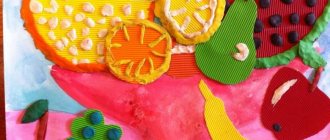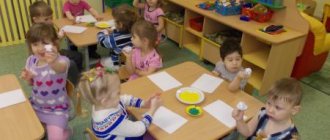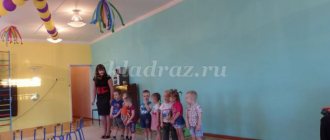Autumn time for children in pictures and coloring pages
Autumn is a beautiful time of the year. It not only pleases the eye, but also brings us its gifts. People collect potatoes, apples, mushrooms in the fall, and animals and birds make abundant supplies for the winter.
And nature simply amazes with its variety of colors. The trees shimmer in all shades of red, golden, greenish, brown, and the sky above your head either frowns or suddenly lights up with heavenly azure.
The charm of autumn is like the mystery of a woman who has learned the experience of life.
Pictures for children
Drawn pictures, photos and coloring books for children will help you understand and feel how beautiful late autumn is. They represent people, animals, gifts of this time of year (apples, nuts, mushrooms), some tree lost in the distance. You can supplement your classes with themed didactic games for autumn, which can be downloaded here.
The favorite tree of many of us in the fall is birch. Slender, white-trunked, she looks like a real beauty among the autumn forest. Late autumn colors the leaves with bright colors, and the birch tree with its white trunk seems to float in the air. This tree is sung in many folklore genres; artists have depicted it with pleasure.
- Here you can download very beautiful pictures about autumn for children.
- And here are the most beautiful autumn pictures for children:
- Forest and lake:
- Deer in the autumn forest thicket:
- The dog runs through the dried autumn leaves:
- Autumn forest:
- Girl in the forest:
- Autumn birch
- Autumn maple leaves:
- children in leaves:
- kitten climbed a maple tree - autumn pictures for children:
- Autumn Harvest:
How can you study them?
You can study the seasons by going out into nature or from pictures. To do this, print them from our website, stick them on thick cardboard or laminate them so that they do not wrinkle. Then ask the guys to tell what late autumn is like and what it brings to people. Ask what gifts of autumn the children know, what animals hibernate during the winter.
If you have printed coloring pages on the “Golden Autumn” theme, let the kids first tell you what colors they will use to paint the leaves and trees. Why is autumn called golden? How to depict this color on paper, since we don’t have gold paint? There may be animals on the coloring pages: let the kids think about what colors to paint them.
And, of course, you will meet a birch tree. Its trunk is white: how to make a birch tree visible on white paper? What songs or poems do kids know about this tree?
Coloring pages
Pictures and coloring pages “Golden Autumn” will contribute to the development of thinking, fine motor skills, and creative abilities . Develop your children! Let them enjoy the beauty of the seasons with you. It is so important for children to love nature!
Source: https://steshka.ru/osen-kartinki-dlya-detej
Short-term project “What did autumn give us?” Sbitneva Natalya Anatolevna
author: Sbitneva Natalya Anatolyevna
teacher of MBDOU general developmental kindergarten No. 8 “Strawberry”
Short-term project “What did autumn give us?”
Methodological development
Short-term creative research project “What did autumn give us?” for the middle group (children 4-5 years old)
Teacher of the highest qualification category
Sbitneva Natalya Anatolevna
We see the relevance of this topic in the fact that most children by the age of 4 have not formed a holistic perception of autumn as a season. Their knowledge and ideas about autumn changes in nature are fragmentary, contradictory and superficial. Children know, for example, that in autumn the leaves change their color, it rains, there are clouds in the sky, but they do not know and cannot tell what autumn gives to a person: it is the time of harvest, collecting and storing vegetables and fruits for the winter; autumn is the most fertile time of the year. This topic requires, in our opinion, long-term, systematic and comprehensive study. Therefore, in our project we are exploring the following topic: what autumn gives to a person, how it is useful and good for him.
Project type: creative research
Project participants: teachers and secondary group students, parents of students.
The goal of the project: to form in children a holistic picture of autumn changes and their meaning for humans.
Project objectives:
- consolidate knowledge about seasonal (autumn)
changes in nature; give ideas about the benefits of natural vitamins; form ideas about the objects of the autumn forest; - teach to reflect acquired knowledge and ideas in creative activities (visual and verbal creativity)
; - develop a caring attitude towards the environment; give basic ideas about the relationship between man and nature;
- to form and develop in children a desire to explore this topic, to independently engage in research and creative activities.
Project location: MBDOU general development kindergarten No. 8 “Strawberry”
Dates: September 1 – September 25, 2022
Stages and content of activities
Stage 1: choosing a topic, setting goals and objectives.
- The teacher offers the children a topic for creative research: “Why do we like autumn, what does it give to a person?”
;
- The teacher formulates (for himself)
the main goal and objectives of the planned project; - During conversations with the teacher, children demonstrate their knowledge on a given topic and express a desire to explore the theme of autumn;
- When discussing a chosen topic at home, parents encourage their child to become familiar with it and offer their help.
Stage 2: search and selection of ways and means to implement the project.
- The teacher draws up a plan for the implementation of the project: outlines plans and topics for events, selects literature, equipment, game attributes;
- Children, together with their parents, select information about autumn phenomena in nature (books, pictures, photographs, etc.)
.
For this purpose, parents organize a trip with their child to the library, bookstore, etc. Together with their parents, children draw pictures on the theme: “An apple with a leaf
,
“Leaves are falling, falling,”
and an applique of autumn leaves.
Stage 3: direct activities to implement the project (educational, research, creative)
.
- The teacher organizes conversations for parents on the topics: “Autumn changes in nature”
,
“Organizing a walk with a child in the autumn forest”
,
“Autumn gifts of nature”
; - The teacher organizes photo sessions and photo exhibitions on the theme: “Golden Autumn”
,
“Autumn is fun!”
; - The teacher creates collages with the children on the theme: “Autumn Leaves”
,
“How Animals Prepare for Winter”
, and make a herbarium from dry autumn leaves. - children use the acquired knowledge in playful, productive, creative, communicative and other types of activities; - During walks, they observe changes in nature, describe them independently or at the request of the teacher, and establish elementary connections between objects and natural phenomena;
- Together with the teacher, they make an album of creative works on the topic: “What did autumn give us?”
- parents contribute to the manifestation of cognitive and creative activity of the child, encourage him; - Parents and children take walks in the forest or park, during which parents talk with children about autumn changes in nature, observe natural objects, and describe them;
- Children, together with their parents, collect natural material for the purpose of its further use in drawing and design classes;
- Parents and children at home do work on the theme: “An apple with a leaf
,
“Leaves are falling, falling,”
and an applique of autumn leaves.
Stage 4: presentation of the project. Summarizing.
- The final event
is the production of crafts
“Gifts of Autumn”
, participation in the project competition on the website of the Academy of Pedagogical Projects of the Russian Federation
Implementation of project goals
.
ECD (direct educational activities)
- “What has autumn brought us?”
Objectives: expand children’s understanding of vegetables and fruits. To consolidate knowledge about seasonal changes in nature. Give an idea of the benefits of natural vitamins.
- “The bear has mushrooms in the forest, I take berries...”
.
Objectives: to consolidate children's knowledge about seasonal changes in nature. Form ideas about forest plants. Expand your understanding of the benefits of natural vitamins for humans and animals.
- Learning from
the quiet poem
“Falling Leaves”
Objectives: to teach children to recite a poem by heart with intonation and expressiveness; exercise in selecting definitions for a given word, encourage them to express their impressions in drawings and movements.
- Game exercise: “What the truck brought us” (fruit)
.
Objectives: to form a generalizing concept “Fruit”
, develop attention, memory, cultivate interest in GCD, independence.
- “The wind sings a song, autumn calls for a visit”
.
Objectives: to introduce children to the distinctive characteristics of the color of trees: birch, maple; expand knowledge about vegetation in autumn; develop observation, memory, speech, cultivate a love of nature.
- A conversation about the signs of early autumn.
Objectives: consolidate knowledge about autumn natural phenomena; learn to describe early autumn; find the difference between summer and autumn; develop attention and thinking; cultivate a love of nature; give ideas about the need to dress for the weather.
Creative. (GCD, educational activities of children in restricted moments)
- “Apple” (modeling)
Objectives: consolidate knowledge about fruits and dishes made from them; practice using familiar sculpting techniques; develop m/m hands; cultivate independence; clarify your idea of healthy eating.
- “Vegetables” (drawing)
Objectives: learn to draw vegetables, conveying their characteristic features; consolidate drawing techniques with colored pencils; develop color perception, cultivate accuracy in work, independence.
- “Grocery store showcase” (applique)
Objectives: to clarify ideas about the work of a seller, to consolidate knowledge about vegetables, to practice using familiar techniques, to encourage beautiful arrangement of elements on a sheet of paper, to use glue carefully, to develop hand skills.
- “Rowan branch” (modeling)
Objectives: consolidate knowledge about the shape of objects (round)
. Learn to sculpt round objects, convey impressions of the environment in sculpting. Cultivate accuracy in work.
- “Leaves are falling, falling” (drawing)
Objectives: teach children to draw an object consisting of straight vertical and inclined lines, place the image in the center of a sheet of paper, draw in the entire sheet.
- “Mushrooms for a hedgehog” (modeling)
Objectives: to consolidate ideas about mushrooms, to give knowledge about poisonous mushrooms, to consolidate the ability to sculpt familiar objects using the techniques of rolling between the palms with straight and circular movements, flattening with the palms, to develop independence, to cultivate accuracy in work.
- “Let’s dress the birch tree in an autumn outfit” (applique)
.
Objectives: continue to teach children to glue ready-made shapes, carefully using a brush and glue. Practice distinguishing primary colors. Cultivate a love for nature.
Observation
.
- Behind the trees and bushes.
Children examine trees, identify and describe their components (trunk, branches, leaves)
.
They compare a tree and a bush, noting that a tree has one long, thick trunk, while a bush has many thin trunks. The teacher invites the children to look at the trees and tell what they are like (the tree is tall, it has beautiful leaves)
;
- Behind the autumn leaves.
Children look at the leaves of rowan, birch, maple and tell what kind of leaves they are (beautiful, green, yellow, orange, large, small, with carved edges). They collect bouquets from leaves, play with leaves (d/i “Which tree is the leaf from?”
,
“Find the same leaf”
, outdoor games
“The wind is blowing, the wind is blowing”
,
“Leaf, find your tree”
) Children watch the leaves fall, note its beauty;
- Behind the flowers in the flowerbed.
The teacher introduces children to “autumn”
flowers - asters, chrysanthemums, marigolds. Children describe the flower they like and sketch it in a group;
- Excursion to the garden.
(Holds in September)
.
In September, the teacher draws the children's attention to how many vegetables grow in the garden: beets, potatoes, onions, cabbage, carrots, greens. During the excursion, the teacher offers to dig up one vegetable from each bed. In the evening, the group holds a conversation on the topic: “Vitamins in the garden”
with a demonstration of vegetables. In October, during an excursion, the teacher draws the children’s attention to the fact that the garden is empty and asks the children to think about what happened to the vegetables.
- Excursion around the territory of the kindergarten.
The theme of the excursion is “Golden Autumn”
. Children watch plants, admire the beauty of autumn nature, share their impressions, and talk about what they saw.
- Group observation.
Examination of illustrations, paintings, demonstration material depicting autumn themes (autumn landscapes, vegetables, fruits, berries, autumn natural phenomena, etc. )
. d). The teacher organizes conversations with children based on visual material, based on the results of walks and excursions. In rainy and windy weather, he organizes observation of natural phenomena from the window. Children formulate the results of observations in speech, the teacher stimulates children to verbal interaction.
Independent activities of children
.
Children’s viewing of pictures and illustrations with objects of living and inanimate nature in the autumn period (series of paintings “Forest Animals”
,
“Trees”
,
“Shrubs”
,
“Herbs”
,
“Birds”
,
“Flowers”
,
“Vegetables and Fruits”
,
“Mushrooms and Berries”
, autumn landscapes, etc.)
Outdoor games “At the bear in the forest...”
,
“Leaf, find your tree”
,
“Vegetables and fruits”
,
“Run under the umbrella”
.
Didactic games “Seasons”
,
“What is your tree’s name?”
,
“Which tree is the leaf from?”
.
Drawing and modeling according to plan (in the evening)
Listening to literary and artistic works by children in the morning and evening.
Interaction with parents
.
Conversations with parents “Autumn changes in nature”
,
“Organizing a walk with a child”
,
“Autumn gifts of nature”
;
Exhibition of vegetables “Gifts of Nature”
;
Homework for children and parents - joint drawings on the theme “Apple with a leaf”
,
“Leaves are falling, falling”
, creating an application from autumn leaves
“Autumn Kaleidoscope”
.
Short-term project “What did autumn give us?” Sbitneva Natalya Anatolevna





